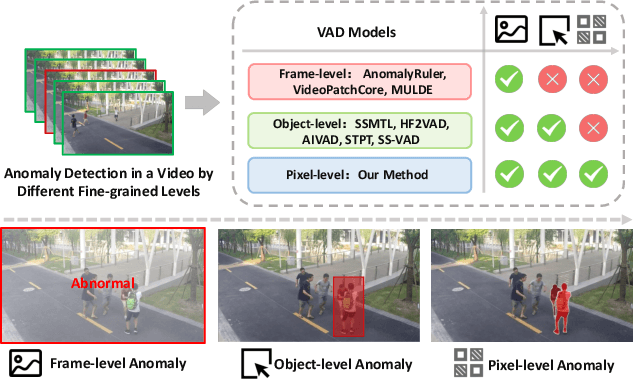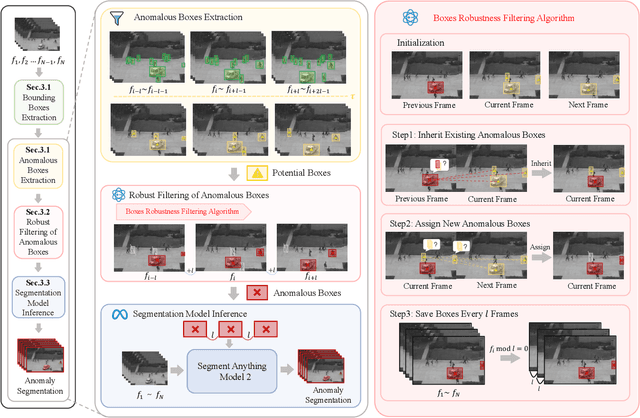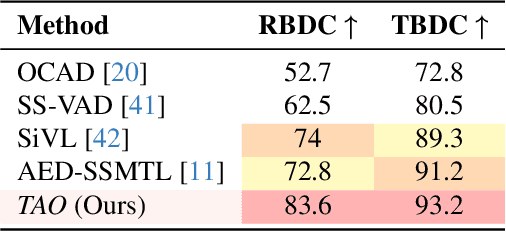Anomaly Detection In Surveillance Videos
Anomaly detection in surveillance videos is the process of identifying unusual or suspicious activities in video footage.
Papers and Code
MoniTor: Exploiting Large Language Models with Instruction for Online Video Anomaly Detection
Oct 24, 2025Video Anomaly Detection (VAD) aims to locate unusual activities or behaviors within videos. Recently, offline VAD has garnered substantial research attention, which has been invigorated by the progress in large language models (LLMs) and vision-language models (VLMs), offering the potential for a more nuanced understanding of anomalies. However, online VAD has seldom received attention due to real-time constraints and computational intensity. In this paper, we introduce a novel Memory-based online scoring queue scheme for Training-free VAD (MoniTor), to address the inherent complexities in online VAD. Specifically, MoniTor applies a streaming input to VLMs, leveraging the capabilities of pre-trained large-scale models. To capture temporal dependencies more effectively, we incorporate a novel prediction mechanism inspired by Long Short-Term Memory (LSTM) networks. This ensures the model can effectively model past states and leverage previous predictions to identify anomalous behaviors. Thereby, it better understands the current frame. Moreover, we design a scoring queue and an anomaly prior to dynamically store recent scores and cover all anomalies in the monitoring scenario, providing guidance for LLMs to distinguish between normal and abnormal behaviors over time. We evaluate MoniTor on two large datasets (i.e., UCF-Crime and XD-Violence) containing various surveillance and real-world scenarios. The results demonstrate that MoniTor outperforms state-of-the-art methods and is competitive with weakly supervised methods without training. Code is available at https://github.com/YsTvT/MoniTor.
Robust Spatiotemporally Contiguous Anomaly Detection Using Tensor Decomposition
Oct 01, 2025Anomaly detection in spatiotemporal data is a challenging problem encountered in a variety of applications, including video surveillance, medical imaging data, and urban traffic monitoring. Existing anomaly detection methods focus mainly on point anomalies and cannot deal with temporal and spatial dependencies that arise in spatio-temporal data. Tensor-based anomaly detection methods have been proposed to address this problem. Although existing methods can capture dependencies across different modes, they are primarily supervised and do not account for the specific structure of anomalies. Moreover, these methods focus mainly on extracting anomalous features without providing any statistical confidence. In this paper, we introduce an unsupervised tensor-based anomaly detection method that simultaneously considers the sparse and spatiotemporally smooth nature of anomalies. The anomaly detection problem is formulated as a regularized robust low-rank + sparse tensor decomposition where the total variation of the tensor with respect to the underlying spatial and temporal graphs quantifies the spatiotemporal smoothness of the anomalies. Once the anomalous features are extracted, we introduce a statistical anomaly scoring framework that accounts for local spatio-temporal dependencies. The proposed framework is evaluated on both synthetic and real data.
Unlocking Vision-Language Models for Video Anomaly Detection via Fine-Grained Prompting
Oct 02, 2025Prompting has emerged as a practical way to adapt frozen vision-language models (VLMs) for video anomaly detection (VAD). Yet, existing prompts are often overly abstract, overlooking the fine-grained human-object interactions or action semantics that define complex anomalies in surveillance videos. We propose ASK-Hint, a structured prompting framework that leverages action-centric knowledge to elicit more accurate and interpretable reasoning from frozen VLMs. Our approach organizes prompts into semantically coherent groups (e.g. violence, property crimes, public safety) and formulates fine-grained guiding questions that align model predictions with discriminative visual cues. Extensive experiments on UCF-Crime and XD-Violence show that ASK-Hint consistently improves AUC over prior baselines, achieving state-of-the-art performance compared to both fine-tuned and training-free methods. Beyond accuracy, our framework provides interpretable reasoning traces towards anomaly and demonstrates strong generalization across datasets and VLM backbones. These results highlight the critical role of prompt granularity and establish ASK-Hint as a new training-free and generalizable solution for explainable video anomaly detection.
HyCoVAD: A Hybrid SSL-LLM Model for Complex Video Anomaly Detection
Sep 26, 2025



Video anomaly detection (VAD) is crucial for intelligent surveillance, but a significant challenge lies in identifying complex anomalies, which are events defined by intricate relationships and temporal dependencies among multiple entities rather than by isolated actions. While self-supervised learning (SSL) methods effectively model low-level spatiotemporal patterns, they often struggle to grasp the semantic meaning of these interactions. Conversely, large language models (LLMs) offer powerful contextual reasoning but are computationally expensive for frame-by-frame analysis and lack fine-grained spatial localization. We introduce HyCoVAD, Hybrid Complex Video Anomaly Detection, a hybrid SSL-LLM model that combines a multi-task SSL temporal analyzer with LLM validator. The SSL module is built upon an nnFormer backbone which is a transformer-based model for image segmentation. It is trained with multiple proxy tasks, learns from video frames to identify those suspected of anomaly. The selected frames are then forwarded to the LLM, which enriches the analysis with semantic context by applying structured, rule-based reasoning to validate the presence of anomalies. Experiments on the challenging ComplexVAD dataset show that HyCoVAD achieves a 72.5% frame-level AUC, outperforming existing baselines by 12.5% while reducing LLM computation. We release our interaction anomaly taxonomy, adaptive thresholding protocol, and code to facilitate future research in complex VAD scenarios.
GTA-Crime: A Synthetic Dataset and Generation Framework for Fatal Violence Detection with Adversarial Snippet-Level Domain Adaptation
Sep 10, 2025Recent advancements in video anomaly detection (VAD) have enabled identification of various criminal activities in surveillance videos, but detecting fatal incidents such as shootings and stabbings remains difficult due to their rarity and ethical issues in data collection. Recognizing this limitation, we introduce GTA-Crime, a fatal video anomaly dataset and generation framework using Grand Theft Auto 5 (GTA5). Our dataset contains fatal situations such as shootings and stabbings, captured from CCTV multiview perspectives under diverse conditions including action types, weather, time of day, and viewpoints. To address the rarity of such scenarios, we also release a framework for generating these types of videos. Additionally, we propose a snippet-level domain adaptation strategy using Wasserstein adversarial training to bridge the gap between synthetic GTA-Crime features and real-world features like UCF-Crime. Experimental results validate our GTA-Crime dataset and demonstrate that incorporating GTA-Crime with our domain adaptation strategy consistently enhances real world fatal violence detection accuracy. Our dataset and the data generation framework are publicly available at https://github.com/ta-ho/GTA-Crime.
AnomalyMoE: Towards a Language-free Generalist Model for Unified Visual Anomaly Detection
Aug 08, 2025Anomaly detection is a critical task across numerous domains and modalities, yet existing methods are often highly specialized, limiting their generalizability. These specialized models, tailored for specific anomaly types like textural defects or logical errors, typically exhibit limited performance when deployed outside their designated contexts. To overcome this limitation, we propose AnomalyMoE, a novel and universal anomaly detection framework based on a Mixture-of-Experts (MoE) architecture. Our key insight is to decompose the complex anomaly detection problem into three distinct semantic hierarchies: local structural anomalies, component-level semantic anomalies, and global logical anomalies. AnomalyMoE correspondingly employs three dedicated expert networks at the patch, component, and global levels, and is specialized in reconstructing features and identifying deviations at its designated semantic level. This hierarchical design allows a single model to concurrently understand and detect a wide spectrum of anomalies. Furthermore, we introduce an Expert Information Repulsion (EIR) module to promote expert diversity and an Expert Selection Balancing (ESB) module to ensure the comprehensive utilization of all experts. Experiments on 8 challenging datasets spanning industrial imaging, 3D point clouds, medical imaging, video surveillance, and logical anomaly detection demonstrate that AnomalyMoE establishes new state-of-the-art performance, significantly outperforming specialized methods in their respective domains.
GV-VAD : Exploring Video Generation for Weakly-Supervised Video Anomaly Detection
Aug 01, 2025Video anomaly detection (VAD) plays a critical role in public safety applications such as intelligent surveillance. However, the rarity, unpredictability, and high annotation cost of real-world anomalies make it difficult to scale VAD datasets, which limits the performance and generalization ability of existing models. To address this challenge, we propose a generative video-enhanced weakly-supervised video anomaly detection (GV-VAD) framework that leverages text-conditioned video generation models to produce semantically controllable and physically plausible synthetic videos. These virtual videos are used to augment training data at low cost. In addition, a synthetic sample loss scaling strategy is utilized to control the influence of generated synthetic samples for efficient training. The experiments show that the proposed framework outperforms state-of-the-art methods on UCF-Crime datasets. The code is available at https://github.com/Sumutan/GV-VAD.git.
Unmasking Performance Gaps: A Comparative Study of Human Anonymization and Its Effects on Video Anomaly Detection
Jul 18, 2025Advancements in deep learning have improved anomaly detection in surveillance videos, yet they raise urgent privacy concerns due to the collection of sensitive human data. In this paper, we present a comprehensive analysis of anomaly detection performance under four human anonymization techniques, including blurring, masking, encryption, and avatar replacement, applied to the UCF-Crime dataset. We evaluate four anomaly detection methods, MGFN, UR-DMU, BN-WVAD, and PEL4VAD, on the anonymized UCF-Crime to reveal how each method responds to different obfuscation techniques. Experimental results demonstrate that anomaly detection remains viable under anonymized data and is dependent on the algorithmic design and the learning strategy. For instance, under certain anonymization patterns, such as encryption and masking, some models inadvertently achieve higher AUC performance compared to raw data, due to the strong responsiveness of their algorithmic components to these noise patterns. These results highlight the algorithm-specific sensitivities to anonymization and emphasize the trade-off between preserving privacy and maintaining detection utility. Furthermore, we compare these conventional anonymization techniques with the emerging privacy-by-design solutions, highlighting an often overlooked trade-off between robust privacy protection and utility flexibility. Through comprehensive experiments and analyses, this study provides a compelling benchmark and insights into balancing human privacy with the demands of anomaly detection.
Track Any Anomalous Object: A Granular Video Anomaly Detection Pipeline
Jun 05, 2025



Video anomaly detection (VAD) is crucial in scenarios such as surveillance and autonomous driving, where timely detection of unexpected activities is essential. Although existing methods have primarily focused on detecting anomalous objects in videos -- either by identifying anomalous frames or objects -- they often neglect finer-grained analysis, such as anomalous pixels, which limits their ability to capture a broader range of anomalies. To address this challenge, we propose a new framework called Track Any Anomalous Object (TAO), which introduces a granular video anomaly detection pipeline that, for the first time, integrates the detection of multiple fine-grained anomalous objects into a unified framework. Unlike methods that assign anomaly scores to every pixel, our approach transforms the problem into pixel-level tracking of anomalous objects. By linking anomaly scores to downstream tasks such as segmentation and tracking, our method removes the need for threshold tuning and achieves more precise anomaly localization in long and complex video sequences. Experiments demonstrate that TAO sets new benchmarks in accuracy and robustness. Project page available online.
ProDisc-VAD: An Efficient System for Weakly-Supervised Anomaly Detection in Video Surveillance Applications
May 04, 2025Weakly-supervised video anomaly detection (WS-VAD) using Multiple Instance Learning (MIL) suffers from label ambiguity, hindering discriminative feature learning. We propose ProDisc-VAD, an efficient framework tackling this via two synergistic components. The Prototype Interaction Layer (PIL) provides controlled normality modeling using a small set of learnable prototypes, establishing a robust baseline without being overwhelmed by dominant normal data. The Pseudo-Instance Discriminative Enhancement (PIDE) loss boosts separability by applying targeted contrastive learning exclusively to the most reliable extreme-scoring instances (highest/lowest scores). ProDisc-VAD achieves strong AUCs (97.98% ShanghaiTech, 87.12% UCF-Crime) using only 0.4M parameters, over 800x fewer than recent ViT-based methods like VadCLIP, demonstrating exceptional efficiency alongside state-of-the-art performance. Code is available at https://github.com/modadundun/ProDisc-VAD.
 Add to Chrome
Add to Chrome Add to Firefox
Add to Firefox Add to Edge
Add to Edge